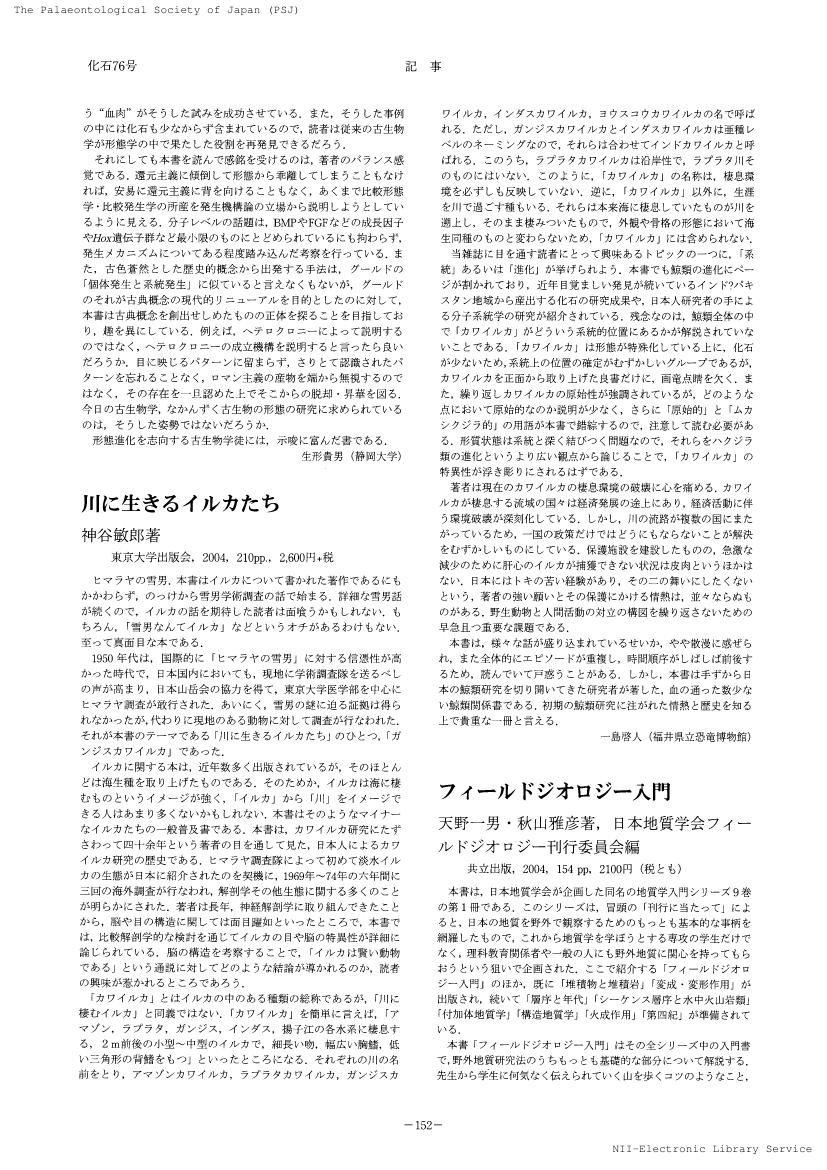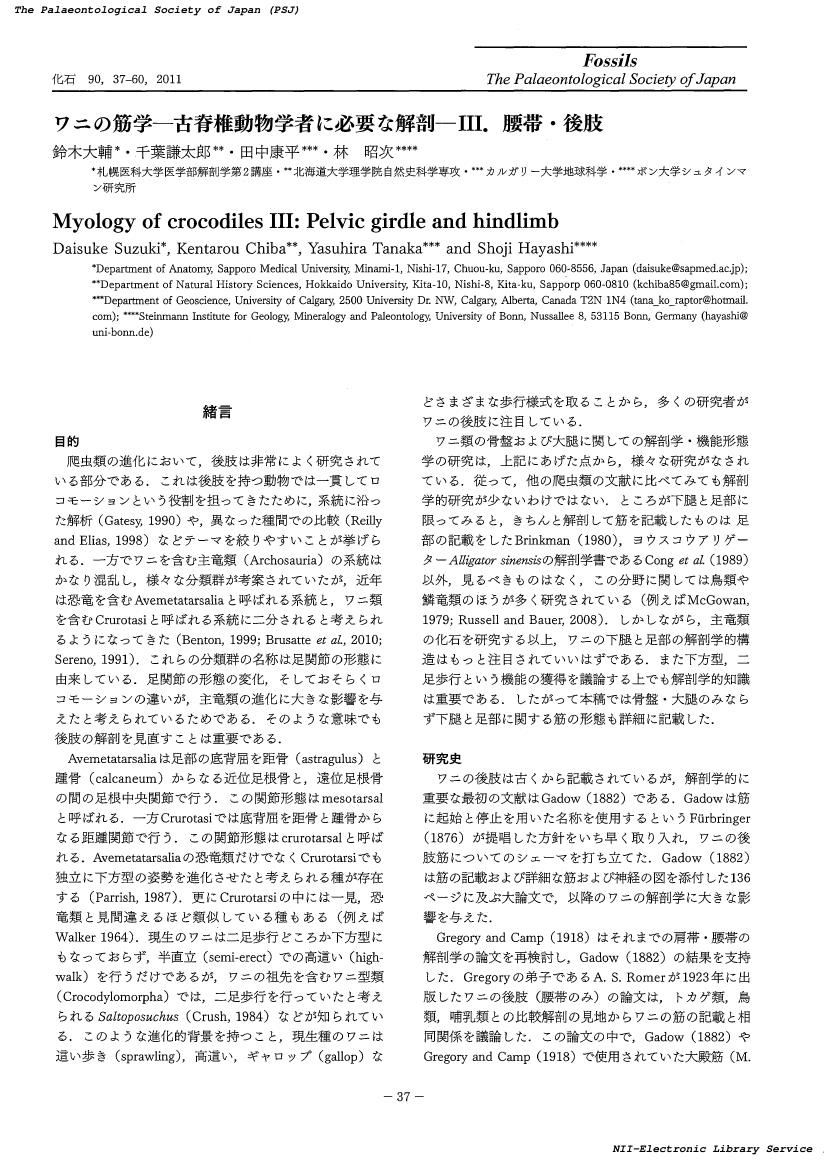58 0 0 0 OA 日本の第四紀淡水魚類化石研究の現状
- 著者
- 宮田 真也
- 出版者
- 日本古生物学会
- 雑誌
- 化石 (ISSN:00229202)
- 巻号頁・発行日
- vol.105, pp.9-20, 2019-03-30 (Released:2019-04-17)
Quaternary freshwater fish fossils are significant to consider the biogeographical history and evolution of Recent and Neogene freshwater fishes. In the present study, previous studies of Quaternary freshwater fish fossils from Japan are reviewed with the updated geological datum of each fossil bed. In Japan, Pleistocene sediments (e.g. Kobiwako Group) have yielded many pharyngeal teeth of cyprinids as well as spines and bones of siluriformes, which contribute to paleobiogeographical and histological studies of these taxa, although the fossils are fragments. Fish fossils from the Miyajima Formation of Tochigi and the Nogami Formation of Oita could possibly be utilized to calibrate molecular clocks of molecular phylogenetics, because these can be identified at the species level based on the articulated and well-preserved fossil specimens. Studies of fish bones and scales from shell mound remains of the Jomon period revealed the existence of extinct cyprinid groups of present Japan and regional extinction during the Holocene time in Japan. These studies are important to discuss the relationships between the transition of fish fauna and human activities.
51 0 0 0 OA 恐竜類の分岐分類におけるクレード名の和訳について
26 0 0 0 OA 西部上総層群産クジラ類化石の概要と更新統における鯨類相
- 著者
- 木村 敏之 樽 創 蔡 政修
- 出版者
- 日本古生物学会
- 雑誌
- 化石 (ISSN:00229202)
- 巻号頁・発行日
- vol.114, pp.37-45, 2023-09-30 (Released:2023-10-09)
This study describes a previously undescribed fossil physeterid from the Pleistocene of Tokyo. This fossil physeterid was recovered from the Early Pleistocene, Fukushima Formation (ca. 1.60‒1.77 Ma), Kazusa Group in 1971 and has long been known as “Hino Kujira” without detailed descriptions. The specimen consists of fragments of the left maxilla, and we estimate the original size of the maxilla can reach at least 3 m long, suggesting an individual at least 11.5 m long. The maxilla is dorsoventrally thick (eroded, but at least 188 mm), and such a thick maxilla clearly differs from that of mysticetes but is similar to that of the modern sperm whale, Physeter macrocephalus. In addition, the average size of each pore on the spongy bone under the compact bone layer is prominent (10 to 15 mm in diameter), consistent with the macroporous structure of the maxilla of modern Physeter macrocephalus. We then provisionally make the taxonomic assignment of this Pleistocene specimen as Physeter sp. Besides, we review seventy-three documented fossil cetaceans from the Pleistocene of Japan, suggesting that the known paleodiversity of the Japanese Pleistocene cetaceans (12 genera) is much lower than that of modern composition (26 genera). This evident discrepancy likely results from the research effort that currently only produces an inadequately known fossil record of cetaceans.
20 0 0 0 異常巻きアンモナイト Nipponites の理論形態
- 著者
- 岡本 隆
- 出版者
- 日本古生物学会
- 雑誌
- 化石 (ISSN:00229202)
- 巻号頁・発行日
- vol.36, pp.37-51, 1984
Nipponitesのら環のシミュレーションおよび標本の形態解析を行った結果, 次のような結論が得られた. (1) Nipponitesの巻きのパターンは全部で9つの係数を有する指数関数と三角関数の組み合わせによって説明することができる. (2) このパターンはx, y, zのどの成分についても原点を中心とした振動関数を示していて, しかも巻きの中心からら環中心までの距離Rの増加率が常に一定となるような, きわめて求心的な関数である. (3) Nipponites 3種(1変種)について, これらの変異を検討した結果, 巻きの基本的なパターンは種間でもほとんど一致していることが分かった. (4) これに対して種間変化の著しい形質は, i) ら環半径の長さに対する成長率とその初期値, ii) Uカーブの程度, iii) 変移点の現われる位置の3点である.これらの形質の違いは, "空間の占有率"に関して大きな差異を生じる原因となっている.
18 0 0 0 OA CTスキャンによる長頸竜亜目鰭化石の真偽判定
18 0 0 0 OA メアリ・アニング (Mary Anning 1799-1847) 研究に学ぶこと
- 著者
- 矢島 道子
- 出版者
- 日本古生物学会
- 雑誌
- 化石 (ISSN:00229202)
- 巻号頁・発行日
- vol.66, pp.34-41, 1999-09-10 (Released:2017-10-03)
- 参考文献数
- 26
メアリ・アニング研究が進んできて, メアリの全貌が少しずつ明らかにされてきた.これは古生物学史が, 英雄伝説ではなく, 社会全体の古生物への認識がどのように変化してきたかを探る, 新しい方向で進み始めたことでもある.ただし, トレンズが1995年に強く批判しているにもかかわらず, 実際には, メアリの紹介がいまだ, 子供時代の発見に集中している.新しい古生物学史もまだ歩み始めたばかりである.科学史家がさらに声を大きくして主張していかねばならない.1998年, イギリス古生物学会はアマチュアへの賞をメアリ・アニング賞と改名した.メアリ・アニングは真のアマチュアであろうかという問題もあるが, ここには, 古生物学を誰が担っていくのかという大きな問題がかくれているように思う.メアリ・アニングの生きていた時代には, 化石の発見そのものが学問を大きく進めていたから, 古生物学者と化石採集家が共同作業をしていたと思う.現在のように化石について研究することと, コレクターとして化石を蒐集することが別ではなかった.化石の研究者と採集者が協力して, 化石への理解を深めていたように思う.現在でも古生物学の本質は変わらないと思う.古生物学者はその学問の意図を多くの人々に明確に示さなければならないだろうし, コレクターは学問の動向を警戒するとはいわないまでも, もっと注目していかなければならないであろう.メアリ・アニングの研究史を通して, もっと古生物学が身近なものになり, 実り豊かな古生物学の研究が生まれてくることを祈る.
15 0 0 0 OA 瑞浪層群宿洞層(岐阜県瑞浪市釜戸町)よりパレオパラドキシア科の全身骨格の発見
14 0 0 0 OA アマミノクロウサギは本当に "ムカシウサギ" か
- 著者
- 冨田 幸光
- 出版者
- 日本古生物学会
- 雑誌
- 化石 (ISSN:00229202)
- 巻号頁・発行日
- vol.63, pp.20-28, 1997-12-20 (Released:2017-10-03)
- 参考文献数
- 27
14 0 0 0 OA 香川県東かがわ市の上部白亜系和泉層群より産出した長頸竜類(爬虫綱,鰭竜目)化石
- 著者
- 中谷 大輔 仲谷 英夫
- 出版者
- 日本古生物学会
- 雑誌
- 化石 (ISSN:00229202)
- 巻号頁・発行日
- vol.113, pp.5-16, 2023-03-31 (Released:2023-04-14)
Plesiosaur fossils are only scarcely known from the Upper Cretaceous of southwestern Japan. Here, we describe a plesiosaur fossil from the Upper Cretaceous Izumi Group of Kagawa Prefecture, southwestern Japan. The fossil is identified as the diaphysis of a left propodeal, and it belongs to an adult individual because the tuberosity or trochanter is differentiated from the capitulum (sense Brown, 1981). The preaxial margin is concave, and the tuberosity or trochanter is narrow and posteriorly located in dorsal view. This combination is observed in some specimens of the Elasmosauridae and Leptocleidia, but preservation of the described propodial is insufficient to identify even at the family level. Therefore, the specimen is identified as an indeterminate Xenopsaria, which is a clade that include the Elasmosauridae and Leptocleidia. Although fragmentary, the specimen is an important record as the first confirmed adult individual of a plesiosaur recorded in this area.
12 0 0 0 OA 日本における軟骨魚類化石研究――現状と展望――
- 著者
- 髙桒 祐司
- 出版者
- 日本古生物学会
- 雑誌
- 化石 (ISSN:00229202)
- 巻号頁・発行日
- vol.109, pp.5-17, 2021-03-31 (Released:2021-04-17)
The research history of fossil Chondrichthyes in Japan has started more than 100 years ago. This paper presents an overview of the studies that have been published since the 1990s, and also advocates future perspective of research subjects of fossil Chondrichthyes in Japan based on the studies. The fossil record of Japanese chondrichthyans, which are mainly composed of elasmobranchs, is an important representative of the present Northwest Pacific region. Those from the Paleozoic (with part of the Triassic) include in limestone blocks within accretionary prisms of subduction zones in the main. They show the developmental process of elasmobranchs in the pelagic region during the Late Paleozoic and the Early Mesozoic. Those from the Mesozoic and Cenozoic are derived from normal clastic deposits. The fossil assemblages from these eras include some of few deep-sea species in the world and tooth sets from some species. These are important evidence of the chondrichthyan faunal transition of the Northwest Pacific region after the Mesozoic. In recent years, some of the fossil records that have passed time since their initial report need to be reclassified based on new taxonomy. Morphological studies on chondrichthyan fossils using CT scan, studies with chemical analyses and other advanced technological methods are also increased. On the other hand, many foreign specimens with high research potential are housed in domestic museums. It is hoped that further research on these foreign specimens and other domestic fossils, such as tooth sets, will reveal much about the evolution of chondrichthyans and the paleoecology of extinct species.
10 0 0 0 OA 長寿二枚貝ビノスガイの殻の地球化学分析を通じた古環境復元〜海流から津波まで〜
- 著者
- 窪田 薫
- 出版者
- 日本古生物学会
- 雑誌
- 化石 (ISSN:00229202)
- 巻号頁・発行日
- vol.111, pp.5-16, 2022-03-31 (Released:2022-04-15)
Unlike the tropical to subtropical areas where reef-building corals are distributed, high latitude paleoenvironmental records with high temporal resolution over the past centuries are scarce. Long-living bivalve shells can be a good candidate for paleoenvironmental recorders. In such a situation, it has recently been revealed that modern cold-water bivalve Mercenaria stimpsoni (Stimpson's hard clam) living in shallow seafloors of North Japan have a lifespan of over 100 years. In this review, details of sclerochronological analysis and analytical procedures oxygen stable isotope and radiocarbon measurements of M. stimpsoni shells collected from shallow seafloors of Funakoshi Bay and Otsuchi Bay are described. Then, ecological (e.g., shell growth patterns) and paleoenvironmental (e.g., oceanic currents, tsunamis) findings that were obtained through these analyses are described.
9 0 0 0 OA 異常巻きアンモナイト Nipponites の理論形態
- 著者
- 岡本 隆
- 出版者
- 日本古生物学会
- 雑誌
- 化石 (ISSN:00229202)
- 巻号頁・発行日
- vol.36, pp.37-51, 1984-11-16 (Released:2017-10-03)
Nipponitesのら環のシミュレーションおよび標本の形態解析を行った結果, 次のような結論が得られた. (1) Nipponitesの巻きのパターンは全部で9つの係数を有する指数関数と三角関数の組み合わせによって説明することができる. (2) このパターンはx, y, zのどの成分についても原点を中心とした振動関数を示していて, しかも巻きの中心からら環中心までの距離Rの増加率が常に一定となるような, きわめて求心的な関数である. (3) Nipponites 3種(1変種)について, これらの変異を検討した結果, 巻きの基本的なパターンは種間でもほとんど一致していることが分かった. (4) これに対して種間変化の著しい形質は, i) ら環半径の長さに対する成長率とその初期値, ii) Uカーブの程度, iii) 変移点の現われる位置の3点である.これらの形質の違いは, "空間の占有率"に関して大きな差異を生じる原因となっている.
8 0 0 0 OA ペルム紀放散虫Follicucullidae科研究の最近の進展
- 著者
- 伊藤 剛 鈴木 紀毅
- 出版者
- 日本古生物学会
- 雑誌
- 化石 (ISSN:00229202)
- 巻号頁・発行日
- vol.112, pp.5-16, 2022-09-30 (Released:2022-10-14)
7 0 0 0 OA 記事(友の会コーナー、議事録、各賞贈呈文、収支決算書、受賞ポスターなど)
- 出版者
- 日本古生物学会
- 雑誌
- 化石 (ISSN:00229202)
- 巻号頁・発行日
- vol.114, pp.52-89, 2023-09-30 (Released:2023-10-09)
- 著者
- 福田 宏
- 出版者
- 日本古生物学会
- 雑誌
- 化石 (ISSN:00229202)
- 巻号頁・発行日
- vol.76, pp.100-106, 2004-09-22 (Released:2017-10-03)
The Recent molluscan fauna of the Ariake Inland Sea is well known as comprising of many unique species. Especially it contains the Chinese Continental faunal elements, which are restricted to the innermost parts of a few large bays of Japan. However, most of them have become extinct or endangered in the recent years because of the rapid artificial change of coastal environment including landfilling, reclamations, bank-protection and pollutions and the destructions of habitats. Also, very few faunal surveys were done before the recent major extinction. Therefore the original molluscan fauna of the Ariake Inland Sea still remains obscure (especially in the subtidal zones). On the other hand, several alien species have artificially been introduced from China or Korea with imported edible clams and also widespread to other areas of Japan through the Ariake Inland Sea. Some of these species had been threatened in Japan before the recent intrusion and it is difficult to distinguish the alien populations from the native ones at present because the lacking of enough records of the original fauna. To solve such confusion and to conserve the native fauna, species, and populations, it is pointed out that the most important thing is the detailed faunal survey and databasing based on extant collection of specimens from now on.
7 0 0 0 OA 持ち運べる角竜類トリケラトプス頭部レプリカキット
- 著者
- 東浦 幸平 岡本 隆
- 出版者
- 日本古生物学会
- 雑誌
- 化石 (ISSN:00229202)
- 巻号頁・発行日
- vol.92, pp.19-30, 2012-09-28 (Released:2017-10-03)
- 参考文献数
- 18
To restore the living attitude of Eubostrychoceras muramotoi Matsumoto, 1967, from the Upper Cretaceous of Hokkaido, Japan, computer simulations based on a newly developed hydrostatic model with hypothesizing negative buoyancy were carried out. The adequacy of restorations was tested by the inclination of ribs which depends tightly on the life orientation of the ammonite during growth. The results of computer simulations suggest that a rapid upside-down of the shell would take place at about one and a half whorls after the shell apex when the ammonite had a small and light phragmocone. This stage corresponds well to the changes in rib inclination observed in the actual specimens, whereas it is significantly late comparative to the previous calculation with hypothesizing neutral buoyancy. These results suggest that E. muramotoi was negatively buoyant and probably had a nektobenthic mode of life. Since the life orientation is essential information for living animals, ammonites would have used it as a "guide" for morphogenesis. The establishment of the new technique covering negatively buoyant shells enables us to make some farther computer simulations in order to understand the meanings of ammonites' shell forms.
- 著者
- 鎮西 清高
- 出版者
- 日本古生物学会
- 雑誌
- 化石 (ISSN:00229202)
- 巻号頁・発行日
- vol.76, pp.152-153, 2004-09-22 (Released:2017-10-03)
5 0 0 0 OA ワニの筋学-古脊椎動物学者に必要な解剖- : III.腰帯・後肢
- 著者
- 伊藤 剛 中村 佳博
- 出版者
- 日本古生物学会
- 雑誌
- 化石 (ISSN:00229202)
- 巻号頁・発行日
- vol.110, pp.3-16, 2021-09-30 (Released:2021-10-15)
Jurassic accretionary complex of the Chichibu belt is distributed in the western Akaishi Mountains, central Japan. The Miocene Wada Formation, composed mainly of mudstone with basal conglomerate, is exposed in Minami-Shinano, Iida City, Nagano Prefecture, central Japan. This article reports the occurrences of Permian, Triassic, and Jurassic radiolarians from the Jurassic accretionary complex and Triassic radiolarians from the chert pebbles within the basal conglomerate of the Wada Formation. The chert pebbles are most probably derived from accretionary complex of the Chichibu belt exposed near the distributional area of the Wada Formation. Meanwhile, clasts of Cretaceous-Paleogene chert derived from the Shimanto belt nor metamorphic rock from the Sambagawa belt have never been discovered from the Wada Formation so far. This implies that the Shimanto and Sambagawa belts have not largely exposed in the Miocene in the hinterland of the Wada Formation.




